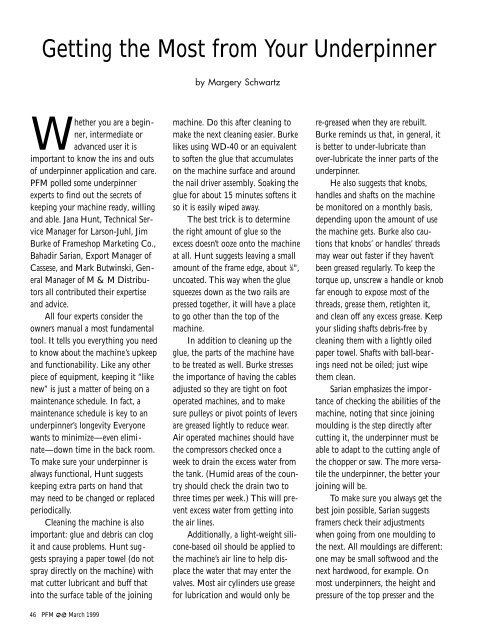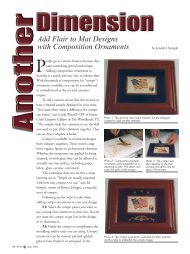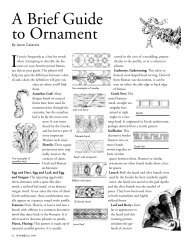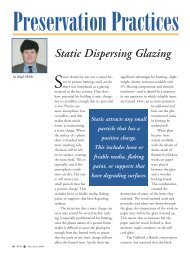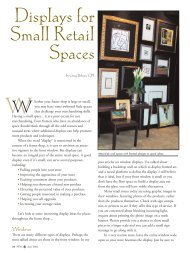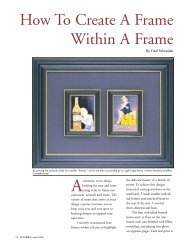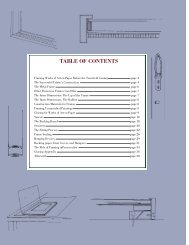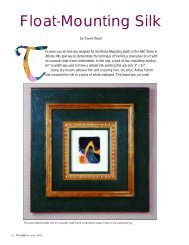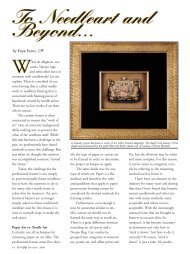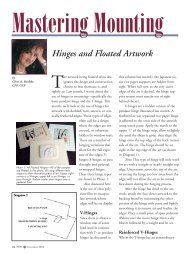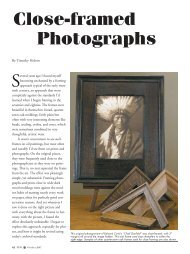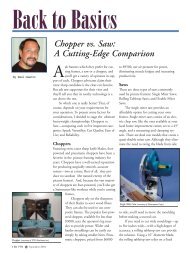Getting the Most from Your Underpinner - Picture Framing Magazine
Getting the Most from Your Underpinner - Picture Framing Magazine
Getting the Most from Your Underpinner - Picture Framing Magazine
Create successful ePaper yourself
Turn your PDF publications into a flip-book with our unique Google optimized e-Paper software.
<strong>Getting</strong> <strong>the</strong> <strong>Most</strong> <strong>from</strong> <strong>Your</strong> <strong>Underpinner</strong><br />
Whe<strong>the</strong>r you are a beginner,<br />
intermediate or<br />
advanced user it is<br />
important to know <strong>the</strong> ins and outs<br />
of underpinner application and care.<br />
PFM polled some underpinner<br />
experts to find out <strong>the</strong> secrets of<br />
keeping your machine ready, willing<br />
and able. Jana Hunt, Technical Service<br />
Manager for Larson-Juhl, Jim<br />
Burke of Frameshop Marketing Co.,<br />
Bahadir Sarian, Export Manager of<br />
Cassese, and Mark Butwinski, General<br />
Manager of M & M Distributors<br />
all contributed <strong>the</strong>ir expertise<br />
and advice.<br />
All four experts consider <strong>the</strong><br />
owners manual a most fundamental<br />
tool. It tells you everything you need<br />
to know about <strong>the</strong> machine’s upkeep<br />
and functionability. Like any o<strong>the</strong>r<br />
piece of equipment, keeping it “like<br />
new” is just a matter of being on a<br />
maintenance schedule. In fact, a<br />
maintenance schedule is key to an<br />
underpinner’s longevity Everyone<br />
wants to minimize—even eliminate—down<br />
time in <strong>the</strong> back room.<br />
To make sure your underpinner is<br />
always functional, Hunt suggests<br />
keeping extra parts on hand that<br />
may need to be changed or replaced<br />
periodically.<br />
Cleaning <strong>the</strong> machine is also<br />
important: glue and debris can clog<br />
it and cause problems. Hunt suggests<br />
spraying a paper towel (do not<br />
spray directly on <strong>the</strong> machine) with<br />
mat cutter lubricant and buff that<br />
into <strong>the</strong> surface table of <strong>the</strong> joining<br />
46 PFM i March 1999<br />
by Margery Schwartz<br />
machine. Do this after cleaning to<br />
make <strong>the</strong> next cleaning easier. Burke<br />
likes using WD-40 or an equivalent<br />
to soften <strong>the</strong> glue that accumulates<br />
on <strong>the</strong> machine surface and around<br />
<strong>the</strong> nail driver assembly. Soaking <strong>the</strong><br />
glue for about 15 minutes softens it<br />
so it is easily wiped away.<br />
The best trick is to determine<br />
<strong>the</strong> right amount of glue so <strong>the</strong><br />
excess doesn’t ooze onto <strong>the</strong> machine<br />
at all. Hunt suggests leaving a small<br />
amount of <strong>the</strong> frame edge, about 1 ⁄8",<br />
uncoated. This way when <strong>the</strong> glue<br />
squeezes down as <strong>the</strong> two rails are<br />
pressed toge<strong>the</strong>r, it will have a place<br />
to go o<strong>the</strong>r than <strong>the</strong> top of <strong>the</strong><br />
machine.<br />
In addition to cleaning up <strong>the</strong><br />
glue, <strong>the</strong> parts of <strong>the</strong> machine have<br />
to be treated as well. Burke stresses<br />
<strong>the</strong> importance of having <strong>the</strong> cables<br />
adjusted so <strong>the</strong>y are tight on foot<br />
operated machines, and to make<br />
sure pulleys or pivot points of levers<br />
are greased lightly to reduce wear.<br />
Air operated machines should have<br />
<strong>the</strong> compressors checked once a<br />
week to drain <strong>the</strong> excess water <strong>from</strong><br />
<strong>the</strong> tank. (Humid areas of <strong>the</strong> country<br />
should check <strong>the</strong> drain two to<br />
three times per week.) This will prevent<br />
excess water <strong>from</strong> getting into<br />
<strong>the</strong> air lines.<br />
Additionally, a light-weight silicone-based<br />
oil should be applied to<br />
<strong>the</strong> machine’s air line to help displace<br />
<strong>the</strong> water that may enter <strong>the</strong><br />
valves. <strong>Most</strong> air cylinders use grease<br />
for lubrication and would only be<br />
re-greased when <strong>the</strong>y are rebuilt.<br />
Burke reminds us that, in general, it<br />
is better to under-lubricate than<br />
over-lubricate <strong>the</strong> inner parts of <strong>the</strong><br />
underpinner.<br />
He also suggests that knobs,<br />
handles and shafts on <strong>the</strong> machine<br />
be monitored on a monthly basis,<br />
depending upon <strong>the</strong> amount of use<br />
<strong>the</strong> machine gets. Burke also cautions<br />
that knobs’ or handles’ threads<br />
may wear out faster if <strong>the</strong>y haven’t<br />
been greased regularly. To keep <strong>the</strong><br />
torque up, unscrew a handle or knob<br />
far enough to expose most of <strong>the</strong><br />
threads, grease <strong>the</strong>m, retighten it,<br />
and clean off any excess grease. Keep<br />
your sliding shafts debris-free by<br />
cleaning <strong>the</strong>m with a lightly oiled<br />
paper towel. Shafts with ball-bearings<br />
need not be oiled; just wipe<br />
<strong>the</strong>m clean.<br />
Sarian emphasizes <strong>the</strong> importance<br />
of checking <strong>the</strong> abilities of <strong>the</strong><br />
machine, noting that since joining<br />
moulding is <strong>the</strong> step directly after<br />
cutting it, <strong>the</strong> underpinner must be<br />
able to adapt to <strong>the</strong> cutting angle of<br />
<strong>the</strong> chopper or saw. The more versatile<br />
<strong>the</strong> underpinner, <strong>the</strong> better your<br />
joining will be.<br />
To make sure you always get <strong>the</strong><br />
best join possible, Sarian suggests<br />
framers check <strong>the</strong>ir adjustments<br />
when going <strong>from</strong> one moulding to<br />
<strong>the</strong> next. All mouldings are different:<br />
one may be small softwood and <strong>the</strong><br />
next hardwood, for example. On<br />
most underpinners, <strong>the</strong> height and<br />
pressure of <strong>the</strong> top presser and <strong>the</strong>
<strong>Getting</strong> <strong>the</strong> <strong>Most</strong> <strong>from</strong> <strong>Your</strong> <strong>Underpinner</strong><br />
wedge insertion mechanism are all<br />
factors that determine <strong>the</strong> quality of<br />
<strong>the</strong> joint.<br />
For example, Sarian insists<br />
framers check <strong>the</strong> wedge <strong>the</strong>y are<br />
using for each join. Some framers<br />
use hardwood wedges for all woods,<br />
but Sarian says this may not be in<br />
<strong>the</strong>ir best interest. There are different<br />
wedges for different kinds of<br />
wood. He suggests making a trial<br />
joint with cut-off waste using standard<br />
and hardwood wedges to see<br />
which will give you <strong>the</strong> best end<br />
result for <strong>the</strong> particular wood you<br />
are currently working with.<br />
Hunt offered <strong>the</strong>se directions<br />
<strong>from</strong> Larson-Juhl’s training manual<br />
for joining wood mouldings with<br />
underpinners: (1) Check moulding<br />
rails for correct length and imperfections.<br />
(2) Separate mouldings by<br />
lengths, putting long to your left<br />
and short to your right. (It’s easy to<br />
remember: long and left begin with<br />
“L.”) (3) Using a strong framing<br />
glue, apply to corner of moulding<br />
(after coloring <strong>the</strong> miter). (4) Insert<br />
one short and one long rail into <strong>the</strong><br />
90° angle fence. (5) Adjust sliding<br />
rabbet clamp for moulding width.<br />
(6) Set <strong>the</strong> wedge placement stops.<br />
(7) Set plunger within 2" <strong>from</strong> top<br />
of moulding by using quick release<br />
handle. (8) Depress mechanism for<br />
firing wedges into bottom of moulding.<br />
(9) Repeat for all four corners.<br />
Burke had some additional<br />
points to make about operating an<br />
underpinner. He feels <strong>the</strong> position of<br />
operation, (back vs. front) is one of<br />
personal preference (though some<br />
48 PFM i March 1999<br />
machines might be easier to operate<br />
<strong>from</strong> one direction). Generally a<br />
machine used <strong>from</strong> <strong>the</strong> front will be<br />
mounted higher than one used <strong>from</strong><br />
<strong>the</strong> back.<br />
Burke points out that <strong>the</strong> top<br />
clamp pad is sometimes changeable.<br />
A v-shaped pad will usually work<br />
best for most profiles that have a<br />
shape to <strong>the</strong>m (scoops, reverses, panels,<br />
etc.). For flat mouldings or<br />
round top shapes, a round pad<br />
works well. Some machines have<br />
rubber pads that conform to <strong>the</strong><br />
moulding’s shape as it’s compressed.<br />
A poorly placed pad, can cause a<br />
gapped corner.<br />
Bu rke says a re verse shoe is good<br />
to use for intricate moulding shapes.<br />
A shoe is made <strong>from</strong> <strong>the</strong> cutout of<br />
<strong>the</strong> moulding, when cut in a single or<br />
double miter saw (<strong>the</strong> scrap center<br />
piece). You can also make <strong>the</strong> two<br />
p a rts by turning <strong>the</strong> moulding<br />
a round in <strong>the</strong> cutter and creating two<br />
s h o rt pieces, 2" to 3" long. The triangle<br />
formed by gluing <strong>the</strong>se two pieces<br />
toge<strong>the</strong>r provides a bridge betwe e n<br />
<strong>the</strong> moulding and <strong>the</strong> pad, cre a t i n g<br />
e ven pre s s u re along <strong>the</strong> pro f i l e .<br />
Burke adds that is handy to have<br />
a 4" triangle made form hard material<br />
such as Plexiglas®, masonite or<br />
hardwood. This triangle can be set<br />
on top of a corner before <strong>the</strong> top<br />
pad comes down to displace and<br />
spread out <strong>the</strong> top clamp pressure on<br />
very soft woods. It also helps<br />
machines with round pads conform<br />
to <strong>the</strong> profile shape. If two pieces of<br />
moulding are not exactly <strong>the</strong> same<br />
height, <strong>the</strong> hard triangle allows <strong>the</strong><br />
machine to flush <strong>the</strong> top of <strong>the</strong><br />
moulding while joining, instead of<br />
having <strong>the</strong> bottom of <strong>the</strong> corner<br />
flush (as when you use soft pads).<br />
Ano<strong>the</strong>r triangle, one with vertical<br />
sides applied to one surface, will<br />
help hold some irregular shapes<br />
when joining. The sides should be<br />
made <strong>from</strong> 1 ⁄4" to 3 ⁄8" thick wood and<br />
be 1" to 1 1 ⁄2" high, glued in a v-shape<br />
to <strong>the</strong> corner of <strong>the</strong> triangle on one<br />
surface, allowing it to hold <strong>the</strong> back<br />
side of some reverse mouldings during<br />
joining.<br />
Burke also uses a small 1 ⁄4" dowel<br />
or glue stick that works well when<br />
mouldings have narrow scoops that<br />
don’t allow a top pad to sit in <strong>the</strong><br />
recess. Cut <strong>the</strong> dowel at a 45° angle<br />
on one end and glue two of <strong>the</strong>m<br />
toge<strong>the</strong>r to form a v-shape, 3" to 4"<br />
long on each leg. (If you use a glue<br />
stick, heat <strong>the</strong> ends with a match<br />
shape and press <strong>the</strong>m toge<strong>the</strong>r.)<br />
These dowels are applied to <strong>the</strong><br />
small scoop of <strong>the</strong> corner before <strong>the</strong><br />
top pad comes down and spaces <strong>the</strong><br />
machine pad above <strong>the</strong> moulding so<br />
<strong>the</strong> pressure is applied inside <strong>the</strong><br />
scooped recess. Usually narrow<br />
mouldings only allow <strong>the</strong> pad to sit<br />
on <strong>the</strong> lip, which tends to break<br />
when you try to insert <strong>the</strong> nail.<br />
Materials you use are just as<br />
important as <strong>the</strong> machine itself.<br />
Burke and Butwinski agree that <strong>the</strong><br />
best thing to do is use nails that are<br />
meant for your particular machine<br />
model; incorrect nails create premature<br />
wear on <strong>the</strong> nail driver.<br />
Nails for underpinners come<br />
sharpened in two formats: with a
<strong>Getting</strong> <strong>the</strong> <strong>Most</strong> <strong>from</strong> <strong>Your</strong> <strong>Underpinner</strong><br />
single bevel (30° to 35°) for soft<br />
woods and double bevel (40° to 45°)<br />
to reduce curling in hardwoods.<br />
Medium-wood nails are a compromise.<br />
Dull nails are a problem and<br />
will cause loose corners in very soft<br />
woods. Butwinski suggests you use<br />
extra sharp softwood nails for softwoods<br />
(such as those <strong>from</strong> South<br />
America and Asia) and plastic<br />
mouldings and hardwood nails for<br />
hardwoods.<br />
Every nail is designed to work in<br />
medium density woods, but <strong>the</strong>re is<br />
a limit to <strong>the</strong> degree of density it can<br />
work with. Poplar and bass are comfortable<br />
with this nail, but a blunt<br />
hardwood nail should be used with a<br />
50 PFM i March 1999<br />
dense oak or ash.<br />
<strong>Most</strong> machines accept nails of<br />
different height up to 5 ⁄8". For soft,<br />
tall mouldings, you can stack <strong>the</strong><br />
nails to help hold <strong>the</strong> face of <strong>the</strong><br />
moulding toge<strong>the</strong>r while <strong>the</strong> glue<br />
cures. For hardwoods, Burke suggests<br />
that you do not stack <strong>the</strong> nails.<br />
Use <strong>the</strong> tallest one for that moulding<br />
and <strong>the</strong> limits of your machine.<br />
Nails bend, so stacking is not necessarily<br />
favorable. Butwinski adds that<br />
nails should be always be loaded<br />
sharp side up.<br />
According to Butwinski, nail<br />
placement is also important. Nails<br />
should be placed in or near <strong>the</strong> center<br />
of <strong>the</strong> profile for <strong>the</strong> best results.<br />
Never join hardwoods closer than 1 ⁄4"<br />
<strong>from</strong> <strong>the</strong> back edge of <strong>the</strong> profile; it<br />
can open up <strong>the</strong> corner joint and<br />
split <strong>the</strong> wood.<br />
Butwinski reminds framers that<br />
it is imperative to have <strong>the</strong> correct<br />
air pressure for <strong>the</strong> type of wood you<br />
are joining. Too little pressure on a<br />
hardwood will not put <strong>the</strong> nail in all<br />
<strong>the</strong> way. Too much pressure on softwoods<br />
may crush or damage <strong>the</strong> top<br />
of <strong>the</strong> profile.<br />
Taking <strong>the</strong> time to learn how to<br />
use and care for your machine<br />
doesn’t just make you more productive,<br />
it will protect your investment<br />
by insuring your underpinner also<br />
has a very long, productive life. ■


